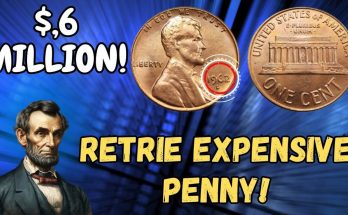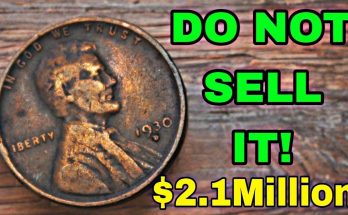💰 BRILLIANT Lincoln Wheat Pennies Worth COLOSSAL Money in Your Collection!
Imagine discovering that a simple old penny tucked away in your coin jar could be worth thousands — or even tens of thousands — of dollars! The image above featuring a classic Lincoln Wheat Penny reminds us that some of the most valuable coins in America are hiding right under our noses. These small copper coins, once used for everyday purchases, now hold colossal value to collectors, historians, and treasure hunters. One rare variety of the Lincoln Wheat Penny has been known to sell for an incredible $65,000 or more!
Let’s dive into what makes these humble coins so extraordinary, how to identify the valuable ones, and why the Lincoln Wheat Cent remains one of the most iconic and collectible coins in U.S. history.
🪙 The Story of the Lincoln Wheat Penny
The Lincoln Wheat Penny was first introduced in 1909, marking the 100th anniversary of Abraham Lincoln’s birth. It was a revolutionary design at the time — the first U.S. coin to feature a real person’s portrait. The obverse (front) shows Abraham Lincoln, designed by sculptor Victor David Brenner, while the reverse (back) displays two stalks of wheat along with the inscriptions “ONE CENT” and “UNITED STATES OF AMERICA,” giving the coin its famous nickname: the Wheat Penny.
From 1909 to 1958, these coins were struck in billions at U.S. Mints in Philadelphia, Denver, and San Francisco. Yet, despite their large numbers, certain years, mintmarks, and rare minting errors make some of these coins worth far more than face value today — sometimes even a small fortune.
🔍 Why Are Some Lincoln Wheat Pennies So Valuable?
Not all Wheat Pennies are created equal. Their value depends on several factors including rarity, condition, mint errors, and historical significance.
Here are some of the key reasons why a simple penny might fetch thousands:
-
Rare Mint Years & Mintmarks
Certain years had very low mintages, making surviving examples incredibly valuable. For example:-
1909-S VDB: The first-year issue from the San Francisco Mint with designer Brenner’s initials “VDB” on the reverse. It’s one of the most famous and sought-after coins, often worth several thousand dollars in good condition.
-
1914-D: A very low-mintage coin from Denver that’s worth thousands, especially in uncirculated condition.
-
1922 No D: A famous mint error where the Denver Mintmark “D” was accidentally left off due to a worn die. These coins can bring tens of thousands of dollars.
-
-
Minting Errors & Variations
Some Wheat Pennies gained value because of unique minting mistakes such as:-
Double Die Errors: When the die used to strike the coin was impressed twice slightly off-alignment, creating doubled images on dates or letters.
-
Off-Center Strikes: Coins struck off-center are rare and can command high premiums.
-
Die Cracks & Cuds: Raised lines or missing areas of design caused by damaged dies are highly collectible among enthusiasts.
-
-
Condition and Color
Coin grading plays a huge role in determining a penny’s worth. Coins that have been preserved with their original “red” luster (abbreviated as RD) are much more valuable than those that have darkened or corroded over time. A Lincoln Wheat Penny graded MS-67RD (Mint State 67 Red) by professional grading companies like PCGS or NGC can sell for thousands of dollars — even for common dates.
💎 The $65,000 Lincoln Wheat Penny
The image above highlights one of the most exciting discoveries in coin collecting — a Lincoln Wheat Penny that sold for $65,000! While that specific value depends on the coin’s date, mintmark, and condition, coins like the 1943 Copper Penny or the 1955 Double Die Obverse have been known to fetch similar amounts.
-
The 1943 Copper Penny is legendary. During World War II, the U.S. Mint switched to zinc-coated steel planchets to conserve copper for the war effort. However, a few copper blanks from 1942 were accidentally used in 1943, resulting in one of the most famous minting mistakes in American history. Only a handful are known to exist, and they can sell for over $100,000.
-
The 1955 Double Die Obverse shows dramatic doubling in the date and lettering “LIBERTY” and “IN GOD WE TRUST.” Even circulated examples can sell for thousands, while mint-state coins can bring well over $50,000.
So yes — it’s entirely possible that a Lincoln Wheat Penny sitting in your change jar could be worth far more than one cent.
🔎 How to Check Your Wheat Pennies
If you’re curious about your coins, here’s how to start:
-
Sort by Date and Mintmark: Look for coins minted between 1909–1958. Pay special attention to those with “S” (San Francisco) or “D” (Denver) mintmarks.
-
Inspect for Errors: Use a magnifying glass or jeweler’s loupe to spot any doubling, misaligned strikes, or missing mintmarks.
-
Check Condition: Bright, red, uncirculated pennies are the most valuable. Store them carefully to prevent tarnish.
-
Weigh and Measure: Authentic wheat pennies should weigh about 3.11 grams. Unusual weights could indicate rare planchet errors.
-
Get Professional Grading: Submitting your coin to PCGS or NGC can authenticate it and potentially multiply its value.
🏆 A Legacy of American History
The Lincoln Wheat Penny isn’t just a collector’s item — it’s a piece of American heritage. It has survived world wars, economic depression, and countless hands of everyday Americans. Collectors cherish these coins not only for their value but for the story they tell: a story of craftsmanship, change, and the enduring image of Abraham Lincoln — the president who symbolizes unity and freedom.
💬 Final Thoughts
The next time you come across an old penny, don’t dismiss it too quickly. It could be a brilliant Lincoln Wheat Penny worth colossal money — perhaps even tens of thousands of dollars! Whether you’re a lifelong numismatist or just starting out, every coin holds a mystery waiting to be discovered. Check your jars, drawers, and piggy banks — your fortune might just be hiding in plain sight.
Keywords: Lincoln Wheat Penny, valuable pennies, rare US coins, coin collecting, 1909-S VDB, 1943 copper penny, 1955 double die penny, rare mint errors, copper coin value, numismatic treasures, coin grading.



